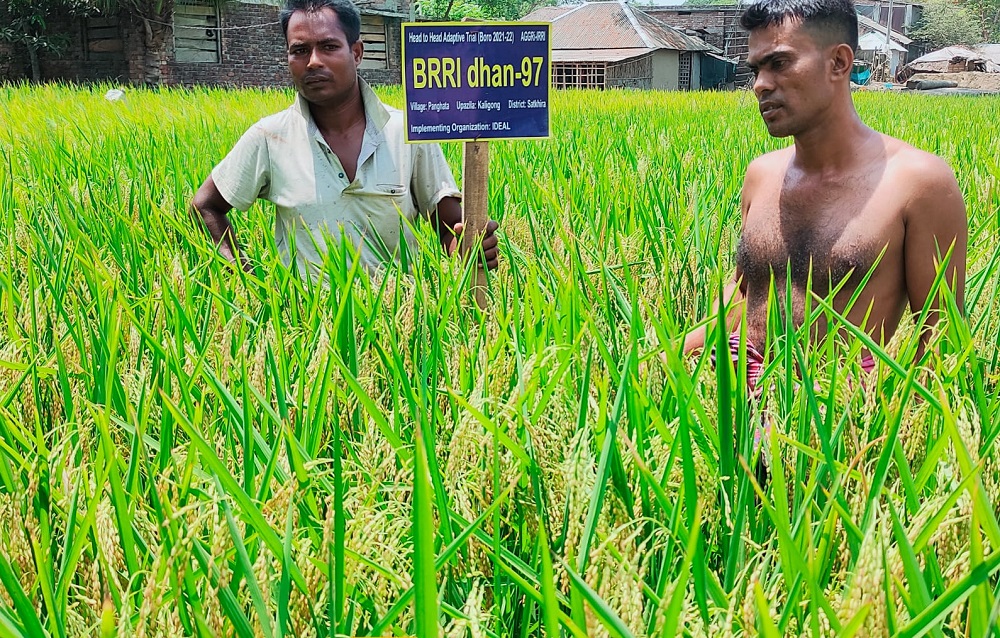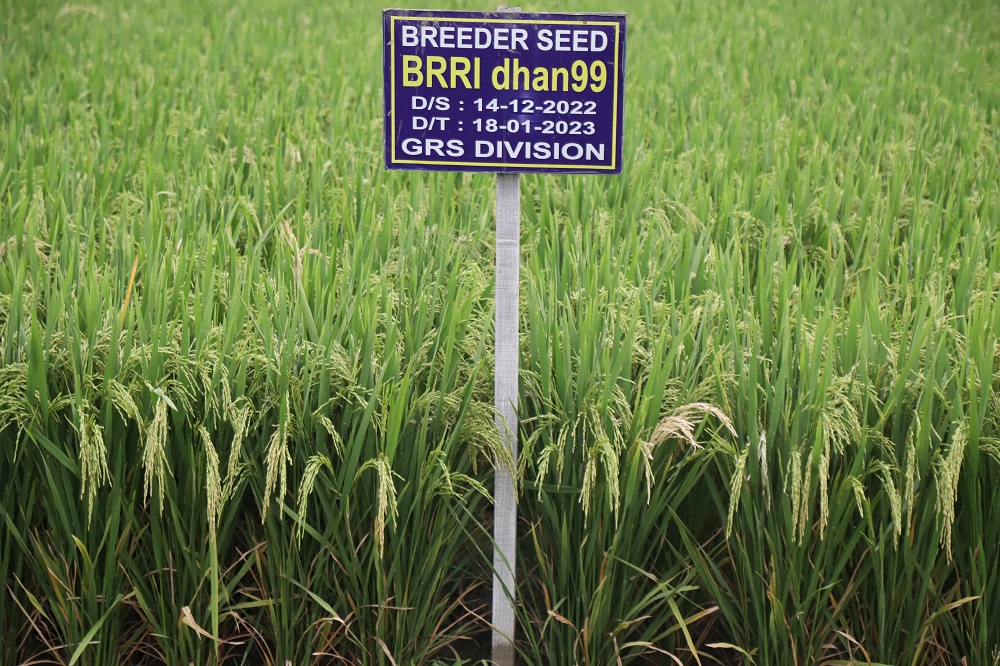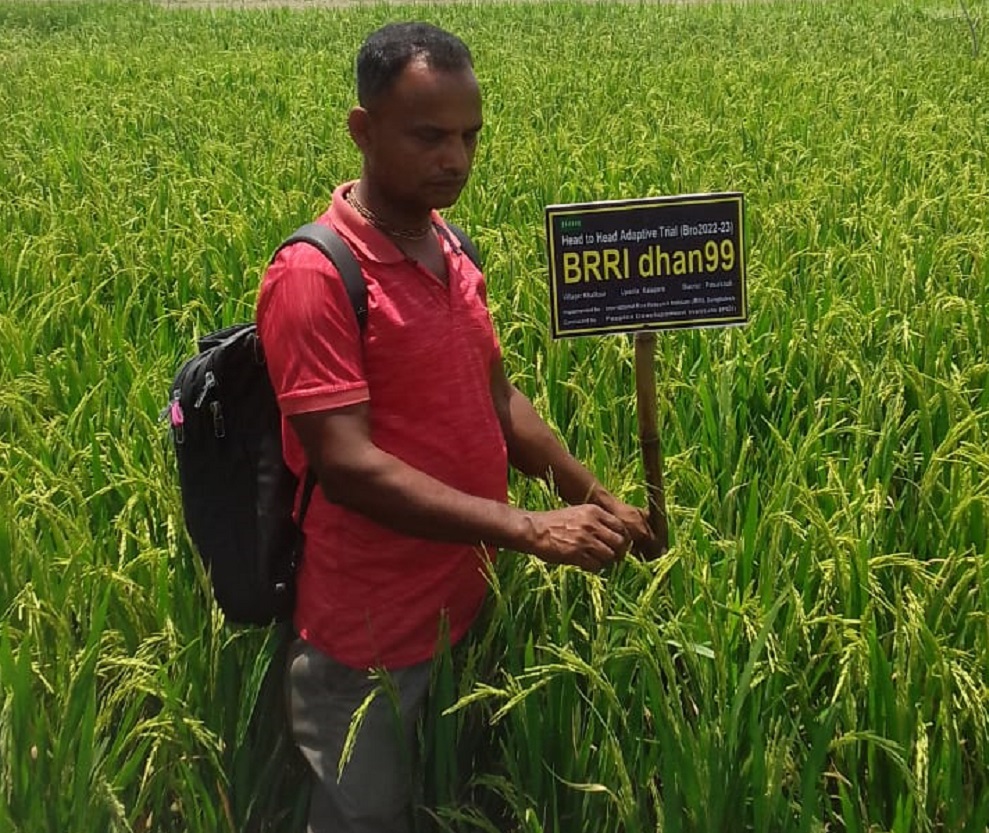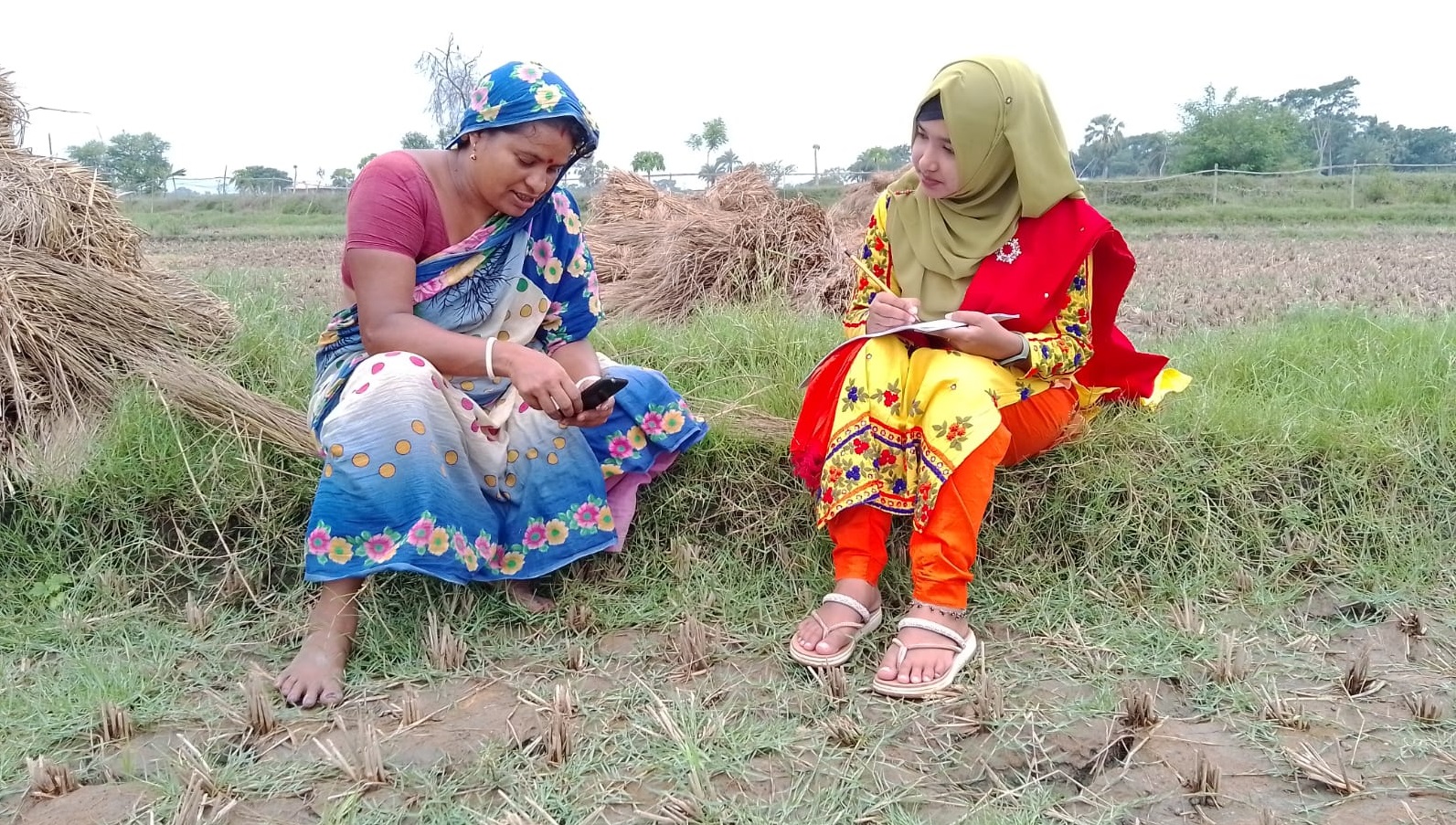Rice cultivation in the salt flats of southern Bangladesh accounts for 25% of the country’s total cultivated land. In this coastal area, characterized by brackish waters, farming has always been a tremendous challenge due to the high salinity levels in the soil. However, a glimmer of hope emerged when the farmers of this region learned about the high-yielding salt-tolerant rice varieties developed to thrive in adverse environments, including saline soil.

In the coastal farmland of Bangladesh, BRRI dhan-97 produced more than 6 tons/ha while the rice varieties planted by farmers only yielded 4.8 tons/ha. (Photo: IRRI Bangladesh)
.
Rice cultivation in the salt flats of southern Bangladesh accounts for 25% of the country’s total cultivated land. In this coastal area, characterized by brackish waters, farming has always been a tremendous challenge due to the high salinity levels in the soil. As farmers struggled to cultivate rice crops under these harsh conditions, their dreams of prosperity seemed to dissipate under the scorching sun.
But the blighted land is just one of the many barriers they have to overcome. Their crops are also susceptible to various pests and diseases that affect their rice production and quality.
The boro season rice crop is the most important in the coastal areas. The most grown variety, BRRI dhan-28, accounts for over 90% of the cultivation in this region. With an average duration of 145 days, the BRRI dhan-28 rice cultivated in coastal areas during the boro season suffers from drought and high soil salinity during the flowering period almost every year.
These cause massive losses for the farmers and pose threats to the food security and livelihood of the people in the region.

Salt-tolerant rice varieties such as BRRI dhan99 are changing the circumstances of Bangladeshi farmers across the country’s coastal lands. (Photo: IRRI Bangladesh)
.
Hope rises from rice
However, a glimmer of hope emerged when the farmers of this region learned about the high-yielding salt-tolerant BRRI dhan-99, BRRI dhan-97, and BINA dhan-10. These varieties were developed to thrive in adverse environments, including saline soil.
BRRI dhan-99, released in 2020, is a long-maturing, high-yielding variety with medium bold grain. It can be harvested in 155 days and produces an average yield of 5.4 tons/hectare. In favorable environments and with proper management, this variety can yield up to 7.1 tons/ha, according to BRRI Director Shahjahan Kabir.
BRRI dhan-97 is a mid-maturing, high-yielding variety with medium bold grain. It can be harvested in 152 days and produces an average yield of 4.9 tons/ha hectare in areas prone to high salinity. It can also produce as much as 7.0 tons/ha in a favorable environment with proper care.
These salt-tolerant varieties were breakthroughs that promised a brighter future for the people who had long struggled against the odds.
The International Rice Research Institute’s (IRRI) One Rice Breeding Strategy, supported by the CGIAR initiative SeedEqual, conducted head-to-head on-farm varietal trials in collaboration with the Bangladesh Rice Research Institute.
Head-to-head trials provide researchers ample scope to assess and validate varietal performances in different saline-prone ecologies to facilitate the process of selecting the most suitable variety for the region.
Equally important, the trials provide farmers with firsthand experience comparing the new varieties’ performance against other varieties in saline soil conditions. Including farmers in varietal selection plays a critical role in popularizing promising varieties within their community. Their participation also helps researchers implement farmer-driven varietal development.

Several farmers from Bishnupur Union in Kaliganj Upazila of Satkhira District conducted head-to-head varietal trials to test the salt-tolerant BRRI dhan-99.and identified it as the best-fit variety for their region. (Photo: IRRI Bangladesh)
.
Changing the story of coastal-land farmers
The collaboration between IRRI, BRRI, and its national research and extension system partners has successfully introduced, tested, and scaled the rice varieties benefiting thousands of smallholder farmers in Bangladesh.
Several farmers from Bishnupur Union in Kaliganj Upazila of Satkhira District in Khulna Division conducted head-to-head varietal trials to test the salt-tolerant BRRI dhan-99.
Md. Arafat, one of the farmers, acquired 20kg of BRRI dhan-99 seeds under IRRI’s Seed System Program. He cultivated that variety on 0.32 hectares of his land along with BRRI dhan-28, BRRI dhan-67, and BRRI dhan-97.
At the end of the trial, he identified BRRI dhan-99 as the best-fit variety for their region and gives a 30% higher yield than the varieties they have been growing.
Other farmers shared their preference for BRRI dhan-99. The variety produced up to 6.1 tons/ha whereas other varieties produced less than 5.5 tons/ha. Most of the farmers have started planting BRRI dhan-99
Haradhon Krishna and Nur Islam were enthusiastic about assessing BRRI dhan-97. They were hoping the variety could be the solution to their existing challenges. BRRI dhan-97 produced more than 6 tons/ha while the farmers check BRRI dhan-28 had only 4.8 tons/ha and the benchmark BRRI dhan-67 produced 5.5 tons/ha.
Shanara Begum, a woman farmer from Nokipur Village in Shyamnagar Upazila, Sathkhira District, was very interested in taking part in IRRI`s head-to-head adaptive trials. She was a progressive farmer who was open to cultivating new varieties and identifying varieties suited for her and the village.
She saw hope when she heard that BRRI and the Bangladesh Institute of Nuclear Agriculture (BINA) released new high-yielding salt-tolerant varieties through IRRI. She was enthusiastic about assessing BRRI dhan-99, BRRI dhan-97. She collected more than 25 kg of seeds from the trial for her own use as well as for neighboring farmers.

The success of the new salt-tolerant rice varieties in the saline areas of Bangladesh shows that where there is hope and determination, even the harshest of environments can give rise to the most extraordinary transformations. (Photo: IRRI Bangladesh)
.
Spreading the resilience
As more farmers started sowing the salt-tolerant rice varieties, their once barren fields underwent a promising transformation. The saline soil, once considered a curse, was now filled with young plants that grew taller and stronger with each passing day.
Inspired by the performance of the new rice varieties, a group of women farmers banded together and formed a cooperative through the Akota Samaj Unnayan Sangstha, a non-government organization that focuses on the youth and women.
The cooperative aims to embark on a journey of transformation, determined to make their arid lands fertile and prosperous. With assistance from IRRI, the women started an informal quality seed production for BRRI dhan-99, BRRI dhan-97, and BINA dhan-10 to increase the availability and accessibility of salt-tolerant varieties in their community and the region.
The success of the new salt-tolerant rice varieties in the saline areas of Bangladesh shows that where there is hope and determination, even the harshest of environments can give rise to the most extraordinary transformations. It is also a symbol of triumph over adversity, reminding us all of the remarkable power of innovation, collaboration, and the human spirit.
About the authors
Muhammad Ashraful Habib is the lead specialist and Swati Nayak is the South Asia lead of Seed System & Product Management at IRRI Bangladesh. Tahmina Akter is an MS student at the Department of Agricultural Extension and Rural Development, Bangabandhu Sheikh Mujibur Rahman Agricultural University, Gazipur.
Promising management strategies to improve crop sustainability and to amend soil salinity







